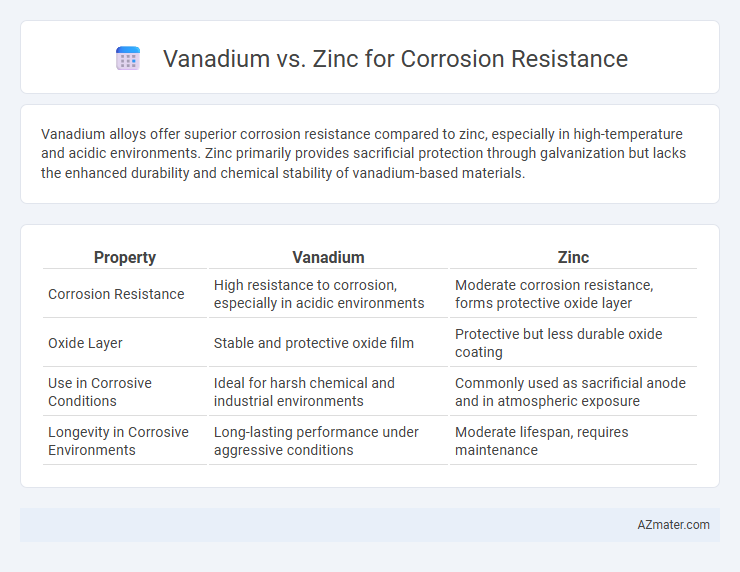Vanadium alloys offer superior corrosion resistance compared to zinc, especially in high-temperature and acidic environments. Zinc primarily provides sacrificial protection through galvanization but lacks the enhanced durability and chemical stability of vanadium-based materials.
Table of Comparison
| Property | Vanadium | Zinc |
|---|---|---|
| Corrosion Resistance | High resistance to corrosion, especially in acidic environments | Moderate corrosion resistance, forms protective oxide layer |
| Oxide Layer | Stable and protective oxide film | Protective but less durable oxide coating |
| Use in Corrosive Conditions | Ideal for harsh chemical and industrial environments | Commonly used as sacrificial anode and in atmospheric exposure |
| Longevity in Corrosive Environments | Long-lasting performance under aggressive conditions | Moderate lifespan, requires maintenance |
Overview of Corrosion Resistance
Vanadium offers superior corrosion resistance in harsh environments due to its ability to form a stable and protective oxide layer, which enhances durability against oxidation and acidic conditions. Zinc typically provides effective sacrificial protection by corroding preferentially to the underlying metal, commonly used in galvanization to prevent steel rusting. While vanadium alloys excel in chemical resistance, zinc's primary role is as a protective coating rather than a bulk material for corrosion resistance.
Chemical Properties: Vanadium vs Zinc
Vanadium exhibits exceptional corrosion resistance due to its ability to form a stable and adherent oxide layer (V2O5), which protects underlying metals in harsh environments. Zinc, known for galvanic protection, offers sacrificial corrosion resistance by preferentially oxidizing and shielding steel substrates through the formation of zinc oxide (ZnO). Chemically, vanadium's higher redox stability and passivation potential make it more effective in resisting corrosion under acidic and oxidative conditions compared to zinc's primarily anodic protection mechanism.
Mechanisms of Corrosion Protection
Vanadium enhances corrosion resistance primarily through the formation of a stable, dense oxide layer that acts as a barrier against environmental attack, effectively reducing metal ion diffusion. Zinc protects by serving as a sacrificial anode, corroding preferentially to the underlying metal and providing galvanic protection. While vanadium improves passive film stability, zinc's mechanism is predominantly anodic protection, making each element suitable for distinct corrosion prevention applications.
Applications in Industry
Vanadium and zinc both serve critical roles in corrosion resistance within various industrial applications, yet their effectiveness varies with context. Zinc is predominantly used as a sacrificial anode in galvanizing steel structures such as bridges, pipelines, and automotive components due to its corrosion-resistant properties and cost-efficiency. Vanadium-enhanced alloys excel in harsh environments like chemical processing and aerospace industries, where their ability to improve steel strength and oxidation resistance under high temperatures significantly extends material lifespan.
Performance in Different Environments
Vanadium exhibits superior corrosion resistance in acidic and high-temperature environments due to its ability to form a stable oxide layer, making it ideal for industrial applications like chemical processing. Zinc performs well in atmospheric and marine environments, providing galvanic protection to steel by sacrificing itself to prevent rust formation. While vanadium excels in harsh chemical conditions, zinc remains the preferred choice for coatings and outdoor structural protection against corrosion.
Cost and Availability Comparison
Vanadium offers superior corrosion resistance in harsh environments but is significantly more expensive and less abundant compared to zinc. Zinc is widely available and cost-effective, making it the preferred choice for large-scale corrosion protection applications such as galvanizing steel. While vanadium's higher cost limits its use to specialized alloys and coatings, zinc's affordability and global supply ensure widespread adoption in industrial and construction sectors.
Environmental Impact and Safety
Vanadium offers superior corrosion resistance in harsh environments but poses higher environmental risks due to its toxicity and extraction impact compared to zinc. Zinc is more environmentally friendly with lower toxicity and widely used for galvanizing steel to prevent corrosion effectively. Both metals require careful handling, but zinc's safer profile and recyclability contribute to reduced environmental footprint in corrosion protection applications.
Longevity and Maintenance Needs
Vanadium alloys exhibit superior corrosion resistance compared to zinc, making them ideal for applications requiring extended longevity in harsh environments. Zinc coatings provide sacrificial protection but demand more frequent maintenance due to gradual depletion over time. Vanadium's enhanced durability reduces maintenance intervals, lowering lifecycle costs and ensuring prolonged structural integrity.
Recent Research and Innovations
Recent research highlights vanadium's superior corrosion resistance in acidic and high-temperature environments compared to zinc, attributed to its ability to form stable passive oxide layers. Innovative nanostructured vanadium coatings demonstrate enhanced durability and self-healing properties, outperforming traditional zinc-based coatings in aggressive industrial settings. Advanced electrochemical studies reveal that vanadium alloys provide longer protection periods, reducing maintenance costs in marine and chemical processing applications.
Choosing the Right Metal for Corrosion Resistance
Vanadium offers superior corrosion resistance in acidic and high-temperature environments compared to zinc, making it ideal for industrial applications requiring durability and strength. Zinc provides effective corrosion protection primarily through galvanization, forming a protective oxide layer that prevents rust in outdoor and marine settings. Selecting the right metal depends on environmental exposure, with vanadium favored for harsh chemical conditions and zinc preferred for cost-effective, general corrosion resistance.

Infographic: Vanadium vs Zinc for Corrosion Resistance
 azmater.com
azmater.com